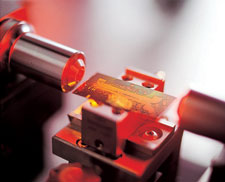
Creating a High-Tech Workforce
Dalton explains that Lumera uses intellectual property generated at the UW and initially was formed to exploit the telecommunications applications. But due to interest in the technology from the Department of Defense and a contract with the National Reconnaissance Office, the company broadened its focus. The sponsored research agreement between Lumera and the UW is nearly $10 million over four years, helped by a $24 million round of financing Lumera received from Cisco Systems in March.
"Lumera is not the end of the game," Dalton says. "They have already formed an agreement with a second company generated by the participants of this center. The economic impact on Seattle and on the nation will be felt in many ways: transportation, telecommunications and personal electronics, among them.
"Companies like Boeing, Lockheed Martin, Lucent and Corning are already winning business based on our technology that they wouldn't have won without it. You will see the same thing with many of the top 30 American corporations as they become participants in our center."
A case in point: a recent discussion with the National Reconnaissance Office regarding a contract for the delivery of global surveillance systems. "We don't want to buy many," Dalton remembers its representatives saying. "But we will buy about 1 million."

Photo by Miquel Khoury, courtesty Microvision.
Dalton's eyes widen. "Electro-optic modulators sell for $5,000 to $30,000 each and they want 1 million. You do the math!" he says. "That's one order. We're not even talking about IBM or Intel, what they want to buy. This is a massive potential market."
Dalton projects just what a marketplace may look like between 2012 and 2015, the logical target to allow for roughly a decade of research and development, and another four years for implementation into the marketplace. "That gives us between now and 2010 (for research and development)," he says. "Just like electronics impacted every aspect of our lives, this will impact every aspect.
"We want to create a whole new workforce that's capable of implementing the technology. Studies show that the U.S. has a crisis in high-tech workforce. It basically comes from overseas. If the INS suddenly allowed no more immigration, there would be no high-tech workforce."
The center hopes that much of that workforce is created right here at UW.
Dalton's group's work will reach beyond chemistry and engineering, calling on the business and law schools to contribute on complicated issues such as intellectual property, technology transfer and entrepreneurship.
Nearly one-third of the NSF award will be funneled back into UW education and outreach, training a new generation of students across a broadly educated spectrum. "There will be a number of educational experiences created whereby students from two important consortiums will study here," Dalton says. "These include the other major research organizations, as well as the designated minority institutions to which we will partner" (see "Research Lights Up the Classroom").
Other major universities participating in the research include CalTech, the University of Southern California, the University of California-Berkeley, the University of California-Santa Barbara and the University of Arizona.
- Page 4: Teaching Science Like Dr. Seuss
- Sidebar: Research Lights Up the Classroom
- Return to September 2002 Table of Contents